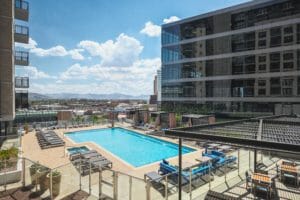Gearing up for another typical Phoenix summer and the All-Star Game at Chase Field in July, the Arizona Diamondbacks have partnered with APS on a solar structure that could be considered a doubleheader.
Just In Time For The All-Star Game, Chase Field’s Solar Structure Will Be A Benefit To Many
Erected in a matter of months above the plaza adjacent to Chase Field’s western entrances and ticket booths, this addition provides fans with welcome shade before they enter the air-conditioned stadium and at the same time generates 75 kilowatts of solar power. That’s enough energy to provide electricity for up to nine homes, APS says.
While no one can say how much cooler — or less steamy — it will be under the 250-foot by 65-foot structure, Arizonans know the difference between being in the sun and being in the shade.
In addition, APS intends to use the solar facility as a technical demonstration project that includes electric vehicle charging stations and a battery storage system. What’s more, the structure features educational exhibits that showcase elements of sustainable living, such as renewable energy, energy efficiency, electric vehicles and recycling.
APS calls a section under the structure “a green energy classroom,” enabling fans to obtain information about living green and saving energy and money. Some displays provide interactive learning opportunities.
Keeping Fans At Chase Field Cool
Derrick Hall, president and CEO of the Diamondbacks, says he wanted to create shade outside the Chase Field ballpark for fans attending the All-Star Game on July 12 and related events inside.
“Because of the heightened security, it does take a bit longer to get into the ballpark,” Hall says. “I approached APS about the idea and they loved it, embraced it, with the solar panels on top.”
An additional element — fans for the fans — includes four ceiling fans, 16-feet in diameter, that will produce a gentle breeze of about 7 mph.
“We want to make sure that the fans are a little more comfortable than they would be without that shade,” Hall says.
APS plans to use the solar facility, which will have a 20-year life span, as a technical demonstration project.
“Behind the scenes, this will be a working laboratory,” says Don Robinson, APS president. “We will study what’s possible with urban solar arrays and how we can power electric vehicles directly from the sun.”
Keeping It Green For Arizona
Dan Wool, APS corporate communications specialist, says the utility paid for the project, which cost slightly less than $1M.
“This project is unique to the Diamondbacks and that space,” Wool says. “Basically, it’s like a small solar power plant.”
Energy generated goes directly into the APS power grid. It gives APS the opportunity to study how such a facility works in a downtown area. The test battery storage system is an effort to meet one of the solar energy challenges in Arizona — peak energy-use period around 4-5 p.m.
Andy Kunasek, chairman of the Maricopa County Board of Supervisors, which also serves as the Maricopa County Stadium District’s governing board, says, “This new structure represents Maricopa County’s ongoing commitment to green practices and sustainability through a unique public-private partnership dedicated to enhancing the quality of life for the citizens of the county and Chase Field (Maricopa County owns Chase Field).”
Chris Jenkins, a designer for project architect HKS Inc., says the Chase Field structure spans 17,000 SF and is supported by a series of steel trusses. Solar panels provide shade for 6,000 SF, and fabric in the team colors of Sedona red and desert tan shields the rest of the structure.
“We want to make sure the fans at the All-Star Game don’t walk away and say, ‘It’s too hot here,’ ” Jenkins says.
He concedes that it’s difficult to avoid the heat in Phoenix during the summer, but adds, “We’re going to do what we can.”
Renewable Energy Contractors, a division of Ironco, was the general contractor for construction of the structure. Malcolm Persen, executive vice president, says his company has been installing solar units throughout Arizona for four years, and describes the Chase Field D-Backs’ project as “far and away a showcase.”


